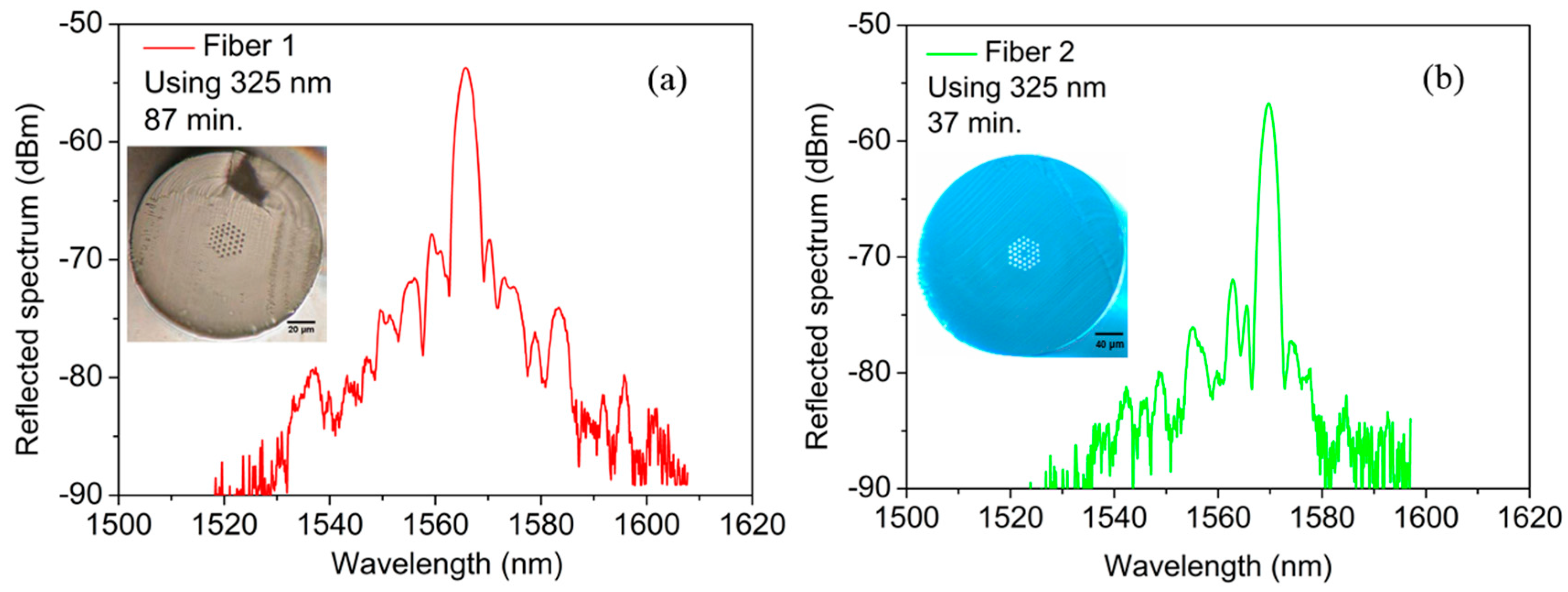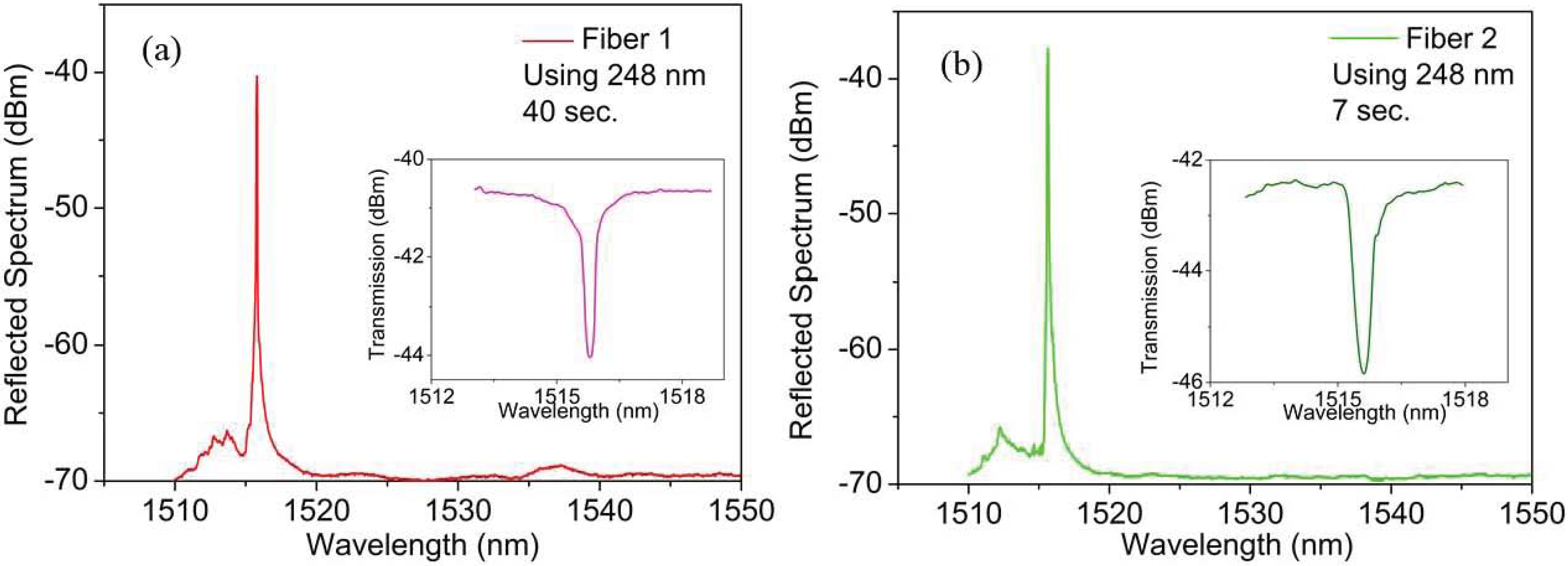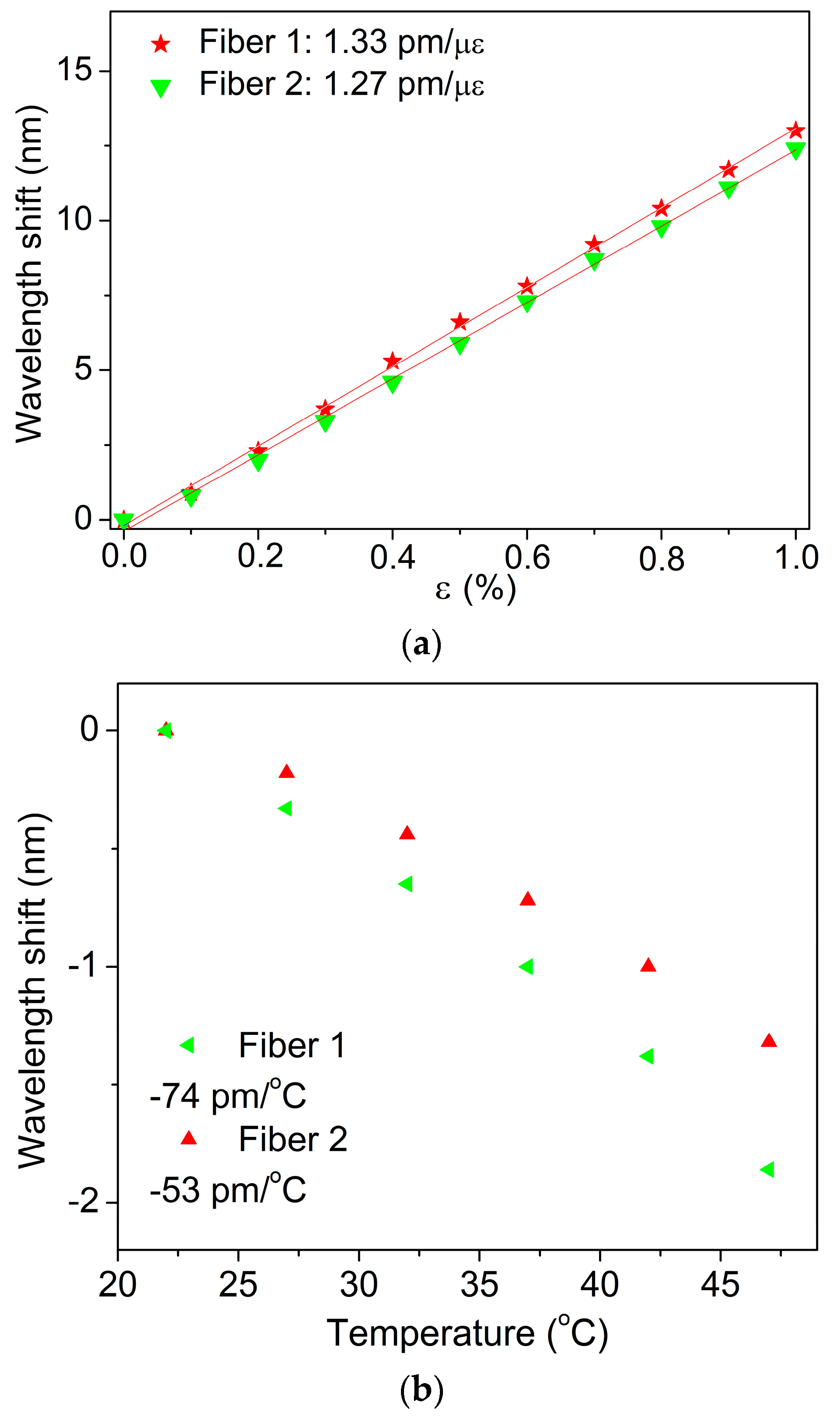Fast Bragg Grating Inscription in PMMA Polymer Optical Fibres: Impact of Thermal Pre-Treatment of Preforms
Abstract
:1. Introduction
2. mPOFs under Investigation and FBG Inscription Systems
3. Results and Discussion
4. Conclusions
Acknowledgments
Author Contributions
Conflicts of Interest
References
- Shao, Y.; Cao, R.; Huang, Y.K.; Ji, P.N.; Zhang, S. 112-Gb/s transmission over 100 m of graded-index POF for optical data center applications. In Proceedings of the Optical Fibre Communication Conference (OFC), Los Angeles, CA, USA, 4–8 March 2012. [Google Scholar]
- Zhou, S.; Reekie, L.; Chan, H.P.; Chow, Y.T.; Chung, P.S.; Luk, K.M. Characterization and modeling of Bragg gratings written in polymer fibre for use as filters in the THz region. Opt. Express 2012, 20, 9564–9571. [Google Scholar] [CrossRef] [PubMed]
- Webb, D.J. Fibre Bragg grating sensors in polymer optical fibres. Meas. Sci. Technol. 2015, 26, 092004. [Google Scholar] [CrossRef]
- Marques, C.; Webb, D.J.; André, P.S. Polymer optical fiber sensors in human life safety. Opt. Fiber Technol. 2017, 36, 144–154. [Google Scholar] [CrossRef]
- Kiesel, S.; Van Vickle, P.; Peters, K.; Hassan, T.; Kowalsky, M. Intrinsic polymer optical fibre sensors for high-strain applications. Smart Struct. Mater. 2005, 6167, 303–311. [Google Scholar]
- Marques, C.A.F.; Bilro, L.; Kahn, L.; Oliveira, R.A.; Webb, D.J.; Nogueira, R.N. Acousto-Optic effect in microstructured polymer fibre Bragg gratings: Simulation and experimental overview. IEEE/OSA J. Lightw. Technol. 2013, 31, 1551–1558. [Google Scholar] [CrossRef]
- Wang, T.X.; Luo, Y.H.; Peng, G.D.; Zhang, Q. High-sensitivity stress sensor based on Bragg grating in BDK-doped photosensitive polymer optical fibre. In Proceedings of the 3rd Asia Pacific Optical Sensors Conference, Sydney, Australia, 31 January–3 February 2012. [Google Scholar]
- Marques, C.A.F.; Peng, G.D.; Webb, D.J. Highly sensitive liquid level monitoring system utilizing polymer fibre Bragg gratings. Opt. Express 2015, 23, 6058–6072. [Google Scholar] [CrossRef] [PubMed]
- Liu, H.B.; Liu, H.Y.; Peng, G.D.; Chu, P.L. Strain and temperature sensor using a combination of polymer and silica fibre Bragg gratings. Opt. Commun. 2003, 219, 139–142. [Google Scholar] [CrossRef]
- Cheng, X.S.; Qiu, W.W.; Wu, W.X.; Luo, Y.; Tian, X.; Zhang, Q.; Zhu, B. High-sensitivity temperature sensor based on Bragg grating in BDK-doped photosensitive polymer optical fibre. Chin. Opt. Lett. 2011, 9, 8–10. [Google Scholar]
- Zhang, W.; Webb, D.J.; Peng, G.D. Investigation into time response of polymer fibre Bragg grating based humidity sensors. IEEE/OSA J. Lightw. Technol. 2012, 30, 1090–1096. [Google Scholar] [CrossRef]
- Hu, X.; Sáez-Rodríguez, D.; Marques, C.A.F.; Bang, O.; Webb, D.J.; Mégret, P.; Caucheteur, C. Polarization effects in polymer FBGs: Study and use for transverse force sensing. Opt. Express 2015, 23, 4581–4590. [Google Scholar] [CrossRef] [PubMed]
- Marques, C.A.F.; Bilro, L.; Alberto, N.J.; Webb, D.J.; Nogueira, R.N. Narrow bandwidth Bragg gratings imprinted in polymer optical fibres for different spectral windows. Opt. Commun. 2013, 307, 57–61. [Google Scholar] [CrossRef]
- Sáez-Rodríguez, D.; Nielsen, K.; Rasmussen, H.K.; Bang, O.; Webb, D.J. Highly photosensitive polymethyl methacrylate microstructured polymer optical fibre with doped core. Opt. Lett. 2013, 38, 3769–3772. [Google Scholar] [CrossRef] [PubMed]
- Yuan, W.; Khan, L.; Webb, D.J.; Kalli, K.; Rasmussen, H.K.; Stefani, A.; Bang, O. Humidity insensitive TOPAS polymer fibre Bragg grating sensor. Opt. Express 2011, 19, 19731–19739. [Google Scholar] [CrossRef] [PubMed]
- Lacraz, A.; Polis, M.; Theodosiou, A.; Koutsides, C.; Kalli, K. Femtosecond laser inscribed Bragg gratings in low loss CYTOP polymer optical fibre. IEEE Photonics Technol. Lett. 2015, 27, 693–696. [Google Scholar] [CrossRef]
- Oliveira, R.; Marques, C.A.F.; Bilro, L.; Nogueira, R.N. Production and characterization of Bragg gratings in polymer optical fibres for sensors and optical communications. In Proceedings of the 23rd International Conference on Optical Fibre Sensors, Santander, Spain, 2–6 June 2014. [Google Scholar]
- Oliveira, R.; Bilro, L.; Nogueira, R.N. Bragg gratings in a few mode microstructured polymer optical fibre in less than 30 s. Opt. Express 2015, 23, 10181–10187. [Google Scholar] [CrossRef] [PubMed]
- Stefani, W.; Yuan, C.; Bang, M.O. Narrow bandwidth 850-nm fibre Bragg gratings in few-mode polymer optical fibres. IEEE Photonics Technol. Lett. 2011, 23, 660–662. [Google Scholar] [CrossRef]
- Stefani, A.; Stecher, M.; Town, G.E.; Bang, O. Direct writing of fibre Bragg grating in microstructured polymer optical fibre. IEEE Photonics Technol. Lett. 2012, 24, 1148–1150. [Google Scholar] [CrossRef]
- Bundalo, I.-L.; Nielsen, K.; Markos, C.; Bang, O. Bragg grating writing in PMMA microstructured polymer optical fibres in less than 7 min. Opt. Express 2014, 22, 5270–5276. [Google Scholar] [CrossRef] [PubMed]
- Luo, Y.; Yan, B.; Li, M.; Zhang, X.; Wu, W.; Zhang, Q.; Peng, G.D. Analysis of multimode POF gratings in stress and strain sensing applications. Opt. Fibre Technol. 2011, 17, 201–209. [Google Scholar] [CrossRef]
- Marques, C.A.F.; Antunes, P.; Mergo, P.; Webb, D.J.; André, P. Chirped Bragg gratings in PMMA step-index polymer optical fiber. IEEE Photonics Technol. Lett. 2017, 29, 500–503. [Google Scholar] [CrossRef]
- Sáez-Rodríguez, D.; Nielsen, K.; Bang, O.; Webb, D.J. Photosensitivity mechanism of undoped poly(methyl methacrylate) under UV radiation at 325 nm and its spatial resolution limit. Opt. Lett. 2014, 39, 3421–3424. [Google Scholar] [CrossRef] [PubMed]
- Acheroy, S.; Merken, P.; Ottevaere, H.; Geernaert, T.; Thienpont, H.; Marques, C.A.F.; Webb, D.J.; Peng, G.-D.; Mergo, P.; Berghmans, F. Thermal effects on the photoelastic coefficient of polymer optical fibres. Opt. Lett. 2016, 41, 2517. [Google Scholar]
- Marques, C.A.F.; Pospori, A.; Sáez-Rodríguez, D.; Nielsen, K.; Bang, O.; Webb, D.J. Fibre optic liquid level monitoring system using microstructured polymer fibre Bragg grating array sensors: Performance analysis. In Proceedings of the 24th International Conference on Optical Fibre Sensors, Curitiba, Brazil, 28 September–2 October 2015. [Google Scholar]
- Woyessa, G.; Nielsen, K.; Stefani, A.; Markos, C.; Bang, O. Temperature insensitive hysteresis free highly sensitive polymer optical fibre Bragg grating humidity sensor. Opt. Express 2016, 24, 1206. [Google Scholar] [CrossRef] [PubMed]
- Yuan, W.; Stefani, A.; Bache, M.; Jacobsen, T.; Rose, B.; Rasmussen, N.H.; Nielsen, F.K.; Andresen, S.; Sørensen, O.B.; Hansen, K.S.; et al. Improved thermal and strain performance of annealed polymer optical fibre Bragg gratings. Opt. Commun. 2011, 284, 176–182. [Google Scholar] [CrossRef]



| Core/Cladding Size (μm) | Cladding Structure | Hole Diameter/Pitch (μm) | Draw Ratio (mm) | Pulling Speed (m/min) | Drawing Temperature (°C)/Tension (N) | Both Preforms Annealed? | |
|---|---|---|---|---|---|---|---|
| Fibre Name | |||||||
| Fibre 1 | 8/135 | Three-Ring Hexagonal | 1.9/4.3 | 20/0.135 | 40 | 290/0.20 | No |
| Fibre 2 | 9/270 | 2.0/4.6 | 11/0.270 | 30 | 290/0.5–1.0 | Yes |
| Using 325 nm Laser | Using 248 nm Laser | |||||
|---|---|---|---|---|---|---|
| Fibre Number | Central Wavelength (nm) | Amplitude (dB) | FWHM (nm) | Central Wavelength (nm) | Amplitude (dB) | FWHM (nm) |
| Fibre 1 | 1565.91 | 32.10 | 5.73 | 1515.80 | 29.88 | 0.16 |
| Fibre 2 | 1569.82 | 31.58 | 5.21 | 1515.63 | 31.68 | 0.25 |
| Strain Sensitivity (pm/με) | Temperature Sensitivity (pm/°C) | |||
|---|---|---|---|---|
| Fibre Number | Pristine Sample | Annealed Sample | Pristine Sample | Annealed Sample |
| Fibre 1 | 1.33 | 1.40 | −74 | −75 |
| Fibre 2 | 1.27 | 1.26 | −53 | −53 |
© 2017 by the authors. Licensee MDPI, Basel, Switzerland. This article is an open access article distributed under the terms and conditions of the Creative Commons Attribution (CC BY) license (http://creativecommons.org/licenses/by/4.0/).
Share and Cite
Marques, C.A.F.; Pospori, A.; Demirci, G.; Çetinkaya, O.; Gawdzik, B.; Antunes, P.; Bang, O.; Mergo, P.; André, P.; Webb, D.J. Fast Bragg Grating Inscription in PMMA Polymer Optical Fibres: Impact of Thermal Pre-Treatment of Preforms. Sensors 2017, 17, 891. https://doi.org/10.3390/s17040891
Marques CAF, Pospori A, Demirci G, Çetinkaya O, Gawdzik B, Antunes P, Bang O, Mergo P, André P, Webb DJ. Fast Bragg Grating Inscription in PMMA Polymer Optical Fibres: Impact of Thermal Pre-Treatment of Preforms. Sensors. 2017; 17(4):891. https://doi.org/10.3390/s17040891
Chicago/Turabian StyleMarques, Carlos A. F., Andreas Pospori, Gökhan Demirci, Onur Çetinkaya, Barbara Gawdzik, Paulo Antunes, Ole Bang, Pawel Mergo, Paulo André, and David J. Webb. 2017. "Fast Bragg Grating Inscription in PMMA Polymer Optical Fibres: Impact of Thermal Pre-Treatment of Preforms" Sensors 17, no. 4: 891. https://doi.org/10.3390/s17040891






